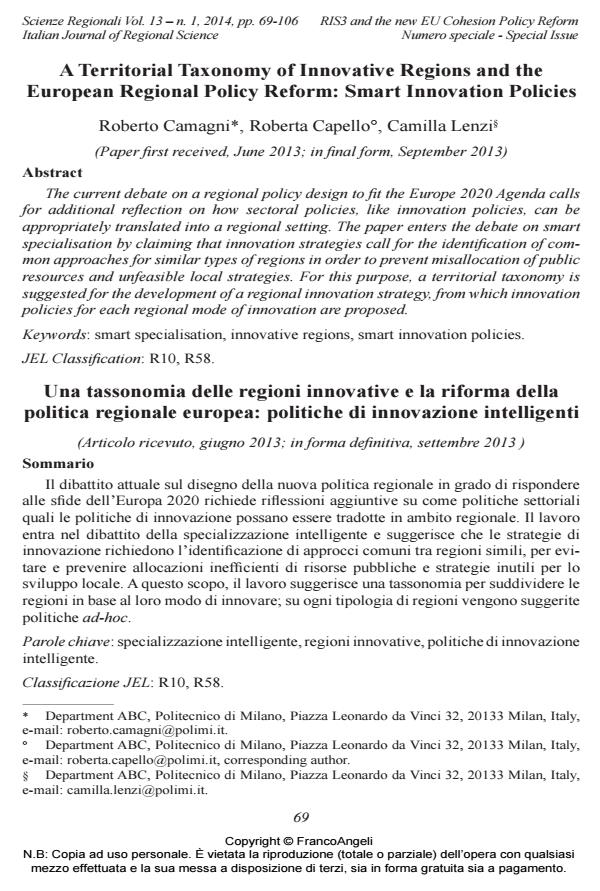A Territorial Taxonomy of Innovative Regions and the European Regional Policy Reform: Smart Innovation Policies
Journal title SCIENZE REGIONALI
Author/s Roberto Camagni, Roberta Capello, Camilla Lenzi
Publishing Year 2014 Issue 2014/1
Language English Pages 37 P. 69-105 File size 1157 KB
DOI 10.3280/SCRE2014-001005
DOI is like a bar code for intellectual property: to have more infomation
click here
Below, you can see the article first page
If you want to buy this article in PDF format, you can do it, following the instructions to buy download credits

FrancoAngeli is member of Publishers International Linking Association, Inc (PILA), a not-for-profit association which run the CrossRef service enabling links to and from online scholarly content.
The current debate on a regional policy design to fit the Europe 2020 Agenda calls for additional reflection on how sectoral policies, like innovation policies, can be appropriately translated into a regional setting. The paper enters the debate on smart specialisation by claiming that innovation strategies call for the identification of common approaches for similar types of regions in order to prevent misallocation of public resources and unfeasible local strategies. For this purpose, a territorial taxonomy is suggested for the development of a regional innovation strategy, from which innovation policies for each regional mode of innovation are proposed.
Keywords: Smart specialisation, innovative regions, smart innovation policies.
Jel codes: R10, R58.ione JEL: R10; R58
- The Centrality of Entrepreneurial Discovery in Building and Implementing a Smart Specialisation Strategy Monica Coffano, Dominique Foray, in SCIENZE REGIONALI 1/2014 pp.33
DOI: 10.3280/SCRE2014-001003 - How ‘Smart’ Are Smart Specialization Strategies? Marco Di Cataldo, Vassilis Monastiriotis, Andrés Rodríguez‐Pose, in JCMS: Journal of Common Market Studies /2022 pp.1272
DOI: 10.1111/jcms.13156 - Regional innovation systems and entrepreneurial ecosystems: their value added to rethinking regional development policies Domingos Santos, in Innovation and Development /2025 pp.473
DOI: 10.1080/2157930X.2024.2381314 - Innovation modes and entrepreneurial behavioral characteristics in regional growth Roberta Capello, Camilla Lenzi, in Small Business Economics /2016 pp.875
DOI: 10.1007/s11187-016-9741-x - Proceedings of the Mediterranean Symposium on Smart City Application Domingos Santos, pp.1 (DOI:10.1145/3175628.3175644)
- Evidence-informed decision-making in Smart Specialisation Strategies: a patent-based approach for discovering regional technological capabilities Angelo Natalicchio, Luca Mora, Lorenzo Ardito, Antonio Messeni Petruzzelli, in Regional Studies /2022 pp.1442
DOI: 10.1080/00343404.2021.1988551 - Smart specialisation in European regions: issues of strategy, institutions and implementation Mikel Landabaso, Philip McCann, Raquel Ortega-Argilés, in European Journal of Innovation Management /2014 pp.409
DOI: 10.1108/EJIM-05-2014-0052 - Smart Specialisation Strategy in practice: have regions changed the allocation of Structural Funds? Diego D’Adda, Donato Iacobucci, Francesco Perugini, in Regional Studies /2022 pp.155
DOI: 10.1080/00343404.2021.1890326 - La governance multilivello delle strategie macro-regionali dell'ue: note critiche Davide Gianluca Bianchi, in SCIENZE REGIONALI 1/2016 pp.5
DOI: 10.3280/SCRE2016-001001 - Territorio y capacidades: actores, redes e innovación Ángelica Montaño Armendáriz, Juana Isabel Vera López, Sarah Eva Martínez Pellegrini, Federico Morales Barragán, Gabriela Muñoz Meléndez, Marcos Sergio Reyes Santos, José Luis Rangel Zaragoza, Juan Antonio Leos Rodríguez, Jorge Aguilar Ávila, Juan Carlos Ramírez Brenes, Gilberto Martínez Sidón, Juan Carlos Pérez Concha, Judith Juárez Mancilla, Plácido Roberto Cruz Chávez, Adilene Sarahí Espinoza Castillo, (ISBN:9786078654864)
- Patterns of policy learning in the RIS3 processes of less developed regions Nicola Bellini, Giulia Lazzeri, Serena Rovai, in Regional Studies /2021 pp.414
DOI: 10.1080/00343404.2020.1762855 - Innovations in Smart Cities Applications Edition 2 Domingos Santos, pp.118 (ISBN:978-3-030-11195-3)
- La spécialisation intelligente, une stratégie réellement pensée pour toutes les régions de l’UE ? Sébastien Bourdin, Olivier Lefèvre, Fabrice Saint, in Géocarrefour /2020
DOI: 10.4000/geocarrefour.15572 - Innovation strategies for smart specialisation (RIS3): Past, present and future research João Lopes, João J. Ferreira, Luís Farinha, in Growth and Change /2019 pp.38
DOI: 10.1111/grow.12268 - Smart specialization and place leadership: dreaming about shared visions, falling into policy traps? Markku Sotarauta, in Regional Studies, Regional Science /2018 pp.190
DOI: 10.1080/21681376.2018.1480902 - SME segmentation and regional development agencies’ innovation support measures Jakub Kruszelnicki, Mikołaj Gołuński, Piotr Ciochoń, Manuel Noya, Esteban Pelayo, Joanna Z˙yra, in Regional Studies, Regional Science /2020 pp.511
DOI: 10.1080/21681376.2020.1811753 - How do stakeholders evaluate smart specialization policies defined for their regions? Luís Farinha, João Lopes, João Renato Sebastião, João José Ferreira, José Oliveira, Paulo Silveira, in Competitiveness Review: An International Business Journal
/2021 pp.594
DOI: 10.1108/CR-12-2019-0149 - Digital meets smart: towards a technology-enhanced approach to Smart Specialisation Strategy development Luca Mora, Anastasia Panori, Mark Deakin, Raquel Ortega-Argiles, in Regional Studies /2022 pp.1421
DOI: 10.1080/00343404.2022.2091775 - Smart Specialisation Strategy and the New EU Cohesion Policy Reform: Introductory Remarks Roberto Capello, in SCIENZE REGIONALI 1/2014 pp.5
DOI: 10.3280/SCRE2014-001001 - Overcoming policy making problems in smart specialization strategies: engaging subregional governments Miren Estensoro, Miren Larrea, in European Planning Studies /2016 pp.1319
DOI: 10.1080/09654313.2016.1174670 - Rationale and Design of EU Cohesion Policies in a Period of Crisis Roberto Camagni, Roberta Capello, in Advanced Engineering Forum /2014 pp.11
DOI: 10.4028/www.scientific.net/AEF.11.11 - Proceedings of the 3rd International Conference on Smart City Applications Domingos Santos, pp.1 (DOI:10.1145/3286606.3286778)
- Seminal Studies in Regional and Urban Economics Roberto Camagni, Roberta Capello, pp.345 (ISBN:978-3-319-57806-4)
- How outward looking is smart specialisation? Rationales, drivers and barriers Elvira Uyarra, Chiara Marzocchi, Jens Sorvik, in European Planning Studies /2018 pp.2344
DOI: 10.1080/09654313.2018.1529146 - Designing and Implementing a Smart Specialisation Strategy at Regional Level: Some Open Questions Donato Iacobucci, in SCIENZE REGIONALI 1/2014 pp.107
DOI: 10.3280/SCRE2014-001006
Roberto Camagni, Roberta Capello, Camilla Lenzi, A Territorial Taxonomy of Innovative Regions and the European Regional Policy Reform: Smart Innovation Policies in "SCIENZE REGIONALI " 1/2014, pp 69-105, DOI: 10.3280/SCRE2014-001005